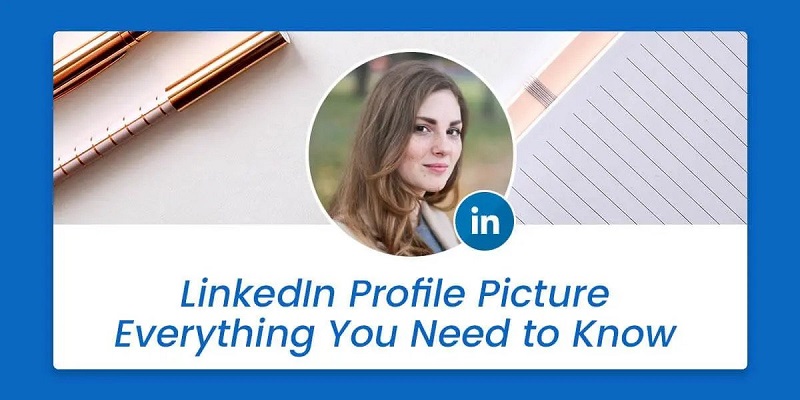1. Introduction
2. Choosing a Professional Profile Picture

a) Dress professionally
Wear attire that aligns with your industry or desired professional image. Dressing appropriately shows that you take your professional presence seriously.b) Smile and make eye contact
A warm and friendly smile can make you appear approachable and confident. Additionally, making eye contact with the camera creates a connection with the viewer.c) Use a high-quality and recent photo
A blurry, pixelated, or outdated photo can create a negative impression. Ensure that your photo is clear, well-lit, and reflects your current appearance.d) Consider the background and lighting
Choose a clean and uncluttered background that doesn't distract from your face. Opt for natural lighting whenever possible, as it tends to be more flattering. Avoid harsh shadows or strong artificial lighting that can distort your features.Remember, your profile picture should represent your professional self and be consistent with the image you want to portray.3. Crafting a Compelling Headline
a) Use keywords
Incorporate relevant keywords related to your industry, skills, or expertise. This helps optimize your profile for search and ensures that you appear in relevant searches by recruiters or professionals seeking specific talents.b) Highlight your unique value proposition
Identify what sets you apart from others in your field and articulate it in your headline. Showcase your key strengths, accomplishments, or specialized knowledge to demonstrate the value you bring to potential employers or connections.c) Keep it concise and clear
Your headline should be succinct and easy to understand at a glance. Aim for a few words or a short phrase that conveys your professional identity effectively.For example, instead of a generic headline like "Marketing Professional," consider a more compelling option like "Results-Driven Marketing Strategist | Boosting Brands and Driving Revenue."Remember to review and update your headline periodically to align with your evolving career goals and accomplishments.4. Writing an Engaging Summary
a) Start with a compelling hook
Begin your summary with a captivating opening sentence or statement that grabs the reader's attention. This can be a thought-provoking question, an intriguing anecdote, or a powerful statement related to your expertise or passion.b) Showcase your professional achievements and expertise
Highlight your key accomplishments, skills, and experiences. Discuss projects you've successfully completed, notable contributions you've made, and any measurable results you've achieved. Quantify your achievements whenever possible to provide concrete evidence of your capabilities.c) Highlight your career goals and aspirations
Share your professional aspirations and what motivates you. This can include your long-term career goals, the impact you want to make in your industry, or the values that drive your work. Showing your ambition and vision can resonate with like-minded professionals and potential employers.d) Use a conversational and authentic tone
Write your summary in a tone that reflects your personality and is easy to understand. Avoid using jargon or overly complex language. Instead, strive for a conversational style that makes it feel like you're having a direct conversation with the reader.Remember to keep your summary concise and focused. Aim for a length of around 3-5 paragraphs or a few impactful bullet points. Finally, proofread your summary carefully to ensure clarity, coherence, and correct grammar.5. Optimizing Experience and Education Sections

a) Experience Section
- Include relevant job titles, company names, and dates: Clearly list your previous and current roles, along with the associated companies and employment periods. This helps potential employers and connections understand your career progression.
- Provide concise and impactful descriptions: For each position, highlight your key responsibilities, notable projects, and achievements. Use action verbs and quantify your accomplishments wherever possible. This demonstrates your abilities and shows tangible results.
- Highlight awards, certifications, or notable projects: If you have received any accolades, certifications, or worked on significant projects, make sure to include them. This helps to further establish your expertise and credibility in your field.
- Add multimedia elements: LinkedIn allows you to enhance your experience section by adding multimedia elements such as links, images, or videos. If you have relevant work samples, portfolios, or presentations, include them to provide a more comprehensive view of your capabilities.
b) Education Section
- List your educational institutions: Include the names of the schools, colleges, or universities you attended. This allows others to understand your educational background and qualifications.
- Highlight degrees, majors, and academic achievements: Mention the degrees you obtained, your field of study, and any academic honors or awards you received. This demonstrates your commitment to education and your expertise in specific areas.
- Include relevant coursework or research projects: If there were specific courses or research projects that are relevant to your professional profile, mention them. This showcases your specialized knowledge and skills.
- Add additional certifications or professional development: If you have acquired any certifications, completed online courses, or participated in relevant professional development programs, include them in this section. This demonstrates your commitment to continuous learning and professional growth.
6. Showcasing Skills and Endorsements
a) Include a diverse range of relevant skills
Choose skills that are directly related to your industry, area of expertise, and the type of opportunities you are seeking. Include both technical and soft skills to provide a comprehensive representation of your abilities.b) Prioritize skills that align with your career goals
Highlight skills that are most relevant to your current career goals or the specific roles you are targeting. This helps recruiters and employers quickly identify your strengths and suitability for their needs.c) Reciprocate by endorsing others' skills
Take the time to endorse the skills of your connections. This not only strengthens your professional relationships but also increases the likelihood of receiving endorsements in return. Be genuine and endorse skills that you have personally witnessed or have knowledge of.d) Highlight your top skills
LinkedIn allows you to select up to three skills to be showcased prominently on your profile. Choose skills that are most relevant and impactful for your professional brand.e) Add skill-specific examples or projects
When describing your experience in the "Experience" section, include specific examples or projects that demonstrate your proficiency in certain skills. This provides concrete evidence of your abilities and can attract more endorsements.Remember to regularly review and update your skills as your professional profile evolves. Also, be cautious not to overinflate your skills or seek endorsements for skills you don't genuinely possess. Authenticity is crucial on LinkedIn.7. Adding Projects, Publications, and Volunteer Experience
a) Projects
- Highlight significant projects or initiatives: Include projects that are relevant to your field or demonstrate your skills and accomplishments. Describe the project's purpose, your role, the challenges faced, and the outcomes achieved. Use measurable results or key achievements to provide concrete evidence of your contributions.
- Showcase your contributions: Clearly outline your specific responsibilities and the impact you had on the project. Mention any leadership roles, innovative ideas, or problem-solving skills that were instrumental in the project's success.
- Add multimedia elements: LinkedIn allows you to add multimedia elements such as links, images, or documents to your projects. If applicable, include samples of your work, project reports, or presentations to provide tangible evidence of your involvement.
b) Publications
- Include authored or contributed articles: If you have written articles, blog posts, or publications in your field, showcase them in this section. Provide the title, publication name, and a brief summary or excerpt to give viewers a glimpse of your writing expertise.
- Add links or PDFs: Attach links to the published articles or upload PDF versions to make them easily accessible. This allows visitors to read your work directly from your profile.
c) Volunteer Experience
- Highlight your volunteer roles and organizations: List the volunteer experiences you've had, including the organizations you've worked with and the causes you've supported. This demonstrates your commitment to giving back and contributing to your community.
- Describe your responsibilities and impact: Clearly explain the tasks and responsibilities you had as a volunteer and the positive impact you made. Quantify your contributions or highlight any special achievements or recognition you received during your volunteer work.
- Emphasize transferable skills: Connect your volunteer experiences to your professional skills by highlighting the transferable skills you developed or utilized during your volunteer work. This helps employers see the value you can bring to their organizations.
8. Building a Professional Network
a) Personalize connection requests
When sending connection requests, personalize each message by mentioning how you know the person or why you would like to connect. This shows genuine interest and increases the likelihood of a positive response.b) Engage with others' content
Like, comment, and share posts from your connections to demonstrate your engagement and interest in their work. This helps you stay on their radar and builds rapport.c) Request informational interviews
Reach out to professionals in your field and request informational interviews. This allows you to learn from their experiences, gain insights, and build relationships. It also opens doors for potential mentorship or future collaboration.d) Share valuable content
Regularly post relevant and insightful content on LinkedIn to showcase your expertise and provide value to your network. This positions you as a thought leader and encourages others to engage with you.e) Offer help and support
Be proactive in offering assistance, advice, or resources to your connections when you can. Actively supporting others strengthens your relationships and builds trust within your network.f) Attend LinkedIn events and webinars
LinkedIn often hosts virtual events and webinars on various professional topics. Participate in these events to learn, connect with industry experts, and expand your network.Remember that building a professional network takes time and effort.9. Keeping Your Profile Updated and Active
a) Engage with your connections
Like, comment, and share content posted by your connections. Engaging with their posts helps to strengthen your professional relationships, keeps you top of mind, and encourages reciprocation when you share your own content.b) Showcase recent projects or portfolio samples
If you've completed new projects or have updated portfolio samples, add them to your profile. This gives visitors a comprehensive view of your capabilities and recent work.c) Review and improve your profile regularly
Set aside time every few months to review and enhance your profile. Check for any outdated information, optimize your keywords, update your profile picture, and ensure all sections are complete and accurate.By keeping your LinkedIn profile updated and active, you maximize your visibility, attract relevant opportunities, and strengthen your professional brand.LinkedIn is an incredible free resource for job seekers and employers alike. The key to attracting recruiters is keeping an updated and active profile. Start with a professional photo that shows your personality. Learn some other LinkedIn tips on our blog: https://t.co/5SeGhgDfVL pic.twitter.com/pfjcz6r2uv
— Work In Ames (@workinames) March 24, 2021

 admin
admin








